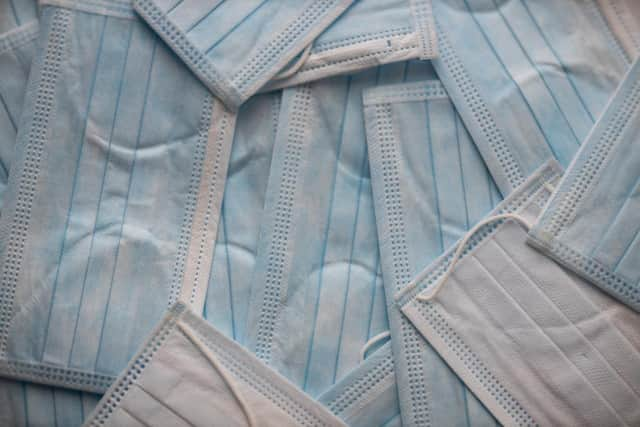Nottinghamshire expert tells you everything you need to know about face masks
and live on Freeview channel 276
As COVID-19 is believed to primarily pass from person-to-person through respiratory droplets and contaminated surfaces, when used correctly, face masks can act as a barrier to help prevent the spread of the virus.
However, wearing a face mask is not common practice in the western world and for many people, it will be their first time using them.
Advertisement
Hide AdAdvertisement
Hide AdFrom homemade fabric masks to FFP3 respirator masks, Shyam Morjaria, medical director at Nottingham-based UK Meds, shares everything you need to know about choosing and using a face mask.


Do masks prevent spread of Covic-19?
“When you cough or sneeze, tiny droplets of saliva and mucus are released into the air and if a person has coronavirus, the virus could be contained within these droplets. If these droplets are then inhaled by another person – or land on a surface that is touched and then inhaled by another person – they too could catch the virus.
“This is why wearing a face mask can contribute to protecting yourself and others from COVID-19. The masks create a shield from any infected droplets and protect your respiratory system to varying degrees.
What are the different types of masks available?
“Respirator masks, which means they are made of a fabric designed to filter the air or impurities, are based on a grading system to indicate how much protection they offer. First up is FFP1, which is the most affordable option. These protect against materials in concentrations of up to 4x OEL (occupational exposure limit) or 4x APF (assigned protection factor).
Advertisement
Hide AdAdvertisement
Hide Ad“Next is FFP2 (also called N95 masks because they are able to filter 95% of smaller particles), which offers more protection, at concentrations up to 12x OEL and 10x APF. The masks that offer the highest level of protection are FFP3 (also called N99, again, because they are able to filter 99 per cent f smaller particles), which protect against materials in concentrations up to 50x OEL or 20x APF. This is substantially higher than FFP1 and they can block both liquid and solid aerosols.
“Current NHS guidelines stipulate FFP3 face masks are best for virus and bacterial infection control when the contagion is spread through coughing and sneezing, such as with the coronavirus.
“Surgical masks are also an option. They are disposable and are sufficient when you are going into areas that are less likely to be contaminated, such as walking outdoors or standing in areas where you know people will practice social distancing correctly.
“The masks need to be disposed of properly after use and how long you can use them for ranges from three to eight hours depending on various external factors and the concentration of the contaminant. While no mask provides complete 100% protection, surgical masks offer a lesser amount of filtration than provided by N95 and N99 masks.”
What about homemade fabric masks?
Advertisement
Hide AdAdvertisement
Hide Ad“Any face covering is better than none, and simple fabric masks can be helpful in preventing the spread of coronavirus. Homemade fabric face masks provide the least amount of protection for all the masks discussed here, but a higher level of protection than not wearing a mask at all. Wear this type of mask when you haven't any other higher filtration masks available to you.”
What type of face mask should I use?
“When it comes to preventing the spread of COVID-19, any type of mask is better than none. Your specific circumstances matter when considering the type of mask to use. Healthcare workers (including family members who care for ill loved-ones) should be using a minimum of FFP2 face masks in the presence of those who are sick with COVID-19.
“On the other hand, if you are walking out in the public and shopping in areas where people are maintaining social distancing, a fabric mask may be sufficient.”
How do I put on a face mask?
“First thing’s first, wash your hands with soap and water or use a hand sanitiser gel to ensure your hands are clean before touching the face mask. You should inspect the mask before wearing it to ensure it’s not damaged or broken, but always pick it up by the fastenings, rather than the mask itself (whether that be headbands, ear loops or ties).
Advertisement
Hide AdAdvertisement
Hide Ad“Bring the mask up to your face and secure it. For ear loops, simply hang these over the tops of your ears. For headbands, loop these over your head and adjust so that they sit comfortably. For ties, secure with a bow.
“Pinch the stiff section across your nose until it moulds comfortably. Make sure your mask is fitting comfortably and covering your nose and mouth (adjust if necessary). Wash your hands again.”
Is there anything I need to be aware of while wearing the face mask?
“Once you’ve successfully fitted your face mask, it’s important that you don’t touch it or the rest of your face. Germs can be spread through touching contaminated surfaces and then touching your nose, eyes or mouth so face masks can act as a good reminder not to do this.
How do I remove a face mask?
Advertisement
Hide AdAdvertisement
Hide Ad“This is potentially the most important step to do correctly. Once you’re ready to remove your face mask, wash hands with soap and water or use a hand sanitiser gel. Never touch the front of your face mask as this is the part that’s susceptible to contamination.
For further health advice or information on UK Meds, visit ukmeds.co.uk or call 0115 907 0050 to speak to one of the company’s experts.